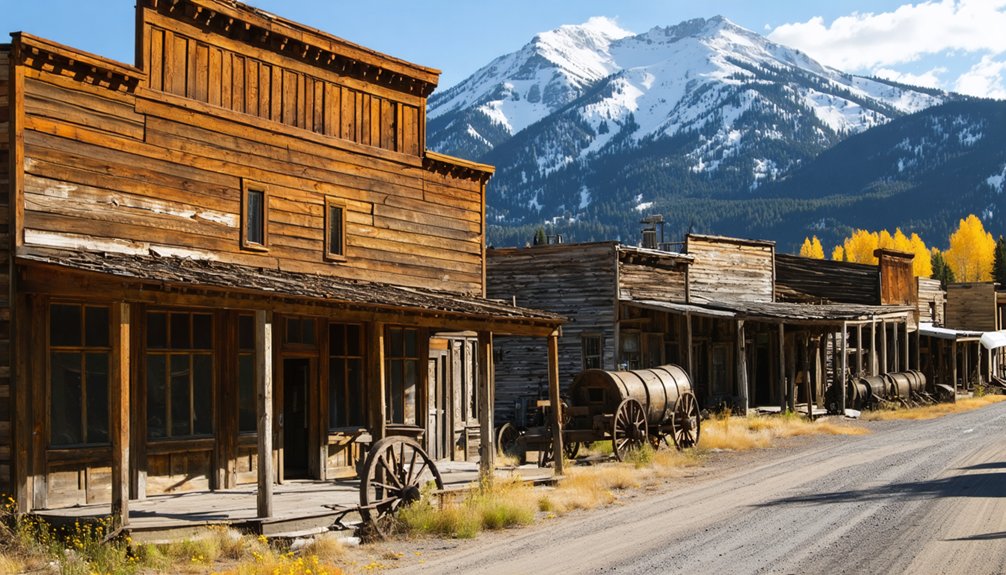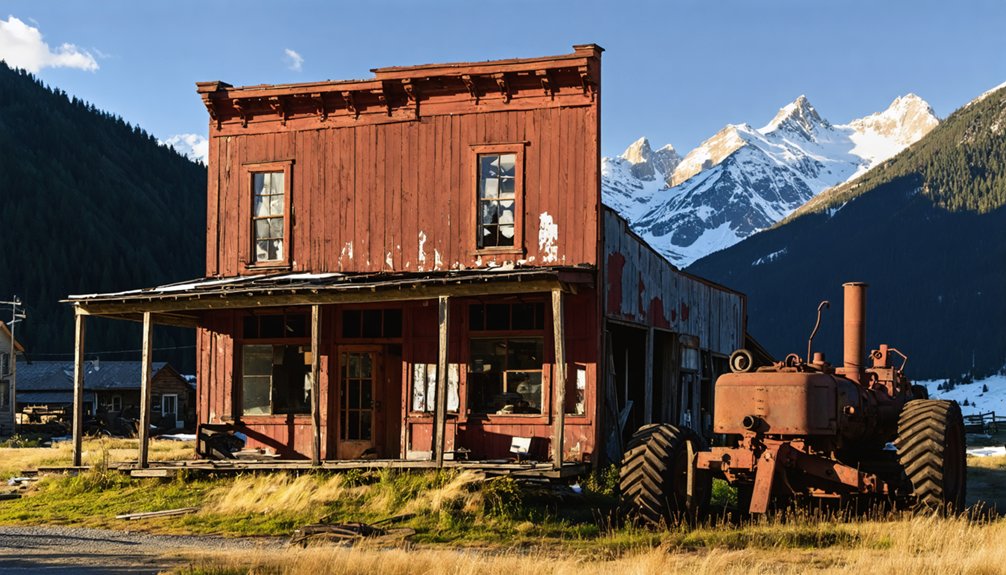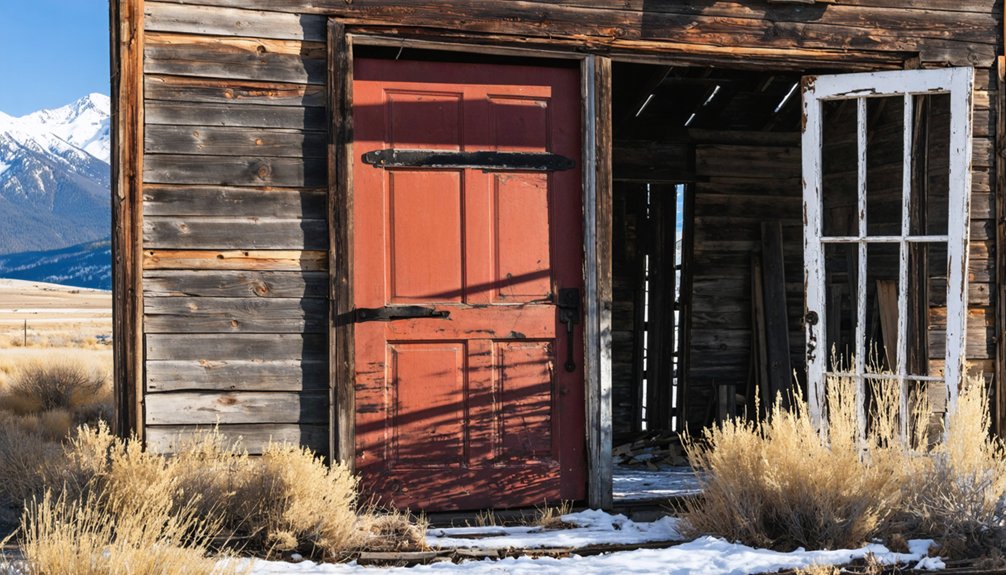You’ll find Garnet Town not in Idaho but in Montana, where it emerged as a thriving mining community in 1895 after Dr. Armistead Mitchell’s discovery. At its peak in 1898, this 6,000-foot elevation settlement housed 1,000 residents, complete with saloons, hotels, and a schoolhouse serving 41 students. The town flourished until the Great Fire of 1910, and today it stands as one of Montana’s best-preserved ghost towns, with countless stories hidden in its weathered structures.
Key Takeaways
- Located at 6,000 feet elevation, Garnet Town was established in 1895 by Dr. Armistead Mitchell following gold and silver discoveries.
- The town reached its peak population of 1,000 in 1898, featuring saloons, hotels, a schoolhouse, and a general store.
- Frank Davey was instrumental in developing the town’s commerce through his general store, stage line, and hotel operations.
- The Great Fire of 1910 contributed to the town’s decline, with Marion Dahl later serving as its final guardian.
- Today, Garnet Ghost Town is accessible via mountain routes from May through late fall, requiring high-clearance vehicles.
A Mining Town Born From Garnet Stone
Despite its name, Garnet Town wasn’t established due to garnet stone mining but rather gold and silver discoveries in the 1860s.
When you explore the town’s history, you’ll find that prospectors first arrived in the area after hearing rumors of rich mineral deposits in the nearby mountains.
You won’t find any evidence of garnet mining operations in the early days, as the town’s founders were solely focused on precious metals.
The settlement quickly grew as miners flocked to the region, establishing claims along the creek beds and hillsides.
While garnets were later discovered in the surrounding hills, they were never the primary focus of the mining operations.
The town’s misleading name actually came from the reddish color of the soil in the area, which resembled garnet stones.
The Rise of Montana’s Hidden Gem
While gold and silver initially drew prospectors to the region, the true story of Garnet Town began in 1895 when Dr. Armistead Mitchell established this hidden gem at 6,000 feet in Montana’s rugged Garnet Mountains.
As advanced mining techniques allowed miners to extract gold from quartz veins, the town’s population swelled to 1,000 by 1898. You’ll find that this wasn’t just another rough mining camp – families settled here, bringing civilization with them. A devastating fire in 1912 destroyed many of the town’s commercial buildings.
The hidden history of Garnet reveals a thriving community with 13 saloons, multiple hotels, stores, and even a schoolhouse. Frank Davey became a prominent figure as he operated a thriving business empire that included a general store, stage line, and hotel. Located 11 miles up Garnet Range Road, the settlement flourished thanks to its proximity to supply towns like Missoula and Deer Lodge.
Despite its remote mountain location, Garnet thrived with a bustling main street filled with saloons, hotels and merchants serving the mining community.
The diverse local economy supported both mining operations and everyday life in this mountain sanctuary.
Life in Peak Mining Years
During Garnet’s peak mining years from 1897-1898, the bustling town reached its zenith with nearly 1,000 residents sharing a uniquely balanced community life.
You’d have found a rare mix of community dynamics, with more married women and families than typical mining settlements, as evidenced by the 41-student schoolhouse.
The mining culture blended rougher elements with family-friendly features. While thirteen saloons dotted the landscape, you’d also discover candy shops, hotels, and barber shops serving daily needs. The Lyle & Fitzgerald saloon would later become the site of a devastating 1912 fire that destroyed most of the town’s commercial buildings.
The ten-stamp mill’s constant operation and frequent dynamite blasts from over 20 active mines provided the soundtrack to daily life. The town later experienced a brief resurgence when gold prices increased under President Roosevelt’s administration.
Mining operations, primarily focused on gold extraction, brought in substantial wealth, with the Nancy Hanks mine alone yielding $300,000 by 1917.
Frank A. Davey’s Legacy
Among Garnet’s most influential figures, Frank A. Davey left an indelible mark on the community from 1898 until 1947. His impact extended far beyond running the general store, as he provided essential services during both boom and bust periods. His store ledgers from 1889-1909 documented the town’s economic life in remarkable detail. His microfilmed records are now housed at the Montana Historical Society in Helena.
Frank A. Davey shaped Garnet for nearly 50 years, transforming a simple general store into the heart of community survival and service.
You’ll find Davey’s community legacy reflected in three key contributions:
- Operating the town’s commercial hub that sold everything from mining tools to jewelry, while also serving as the post office.
- Supporting newlyweds through his “Honeymoon Cabin” program, offering temporary housing until they could build their own homes.
- Maintaining crucial services through challenging times, including the 1912 fire and population decline.
After his death in 1947, the Bureau of Land Management preserved his store, which now stands as a memorial to Garnet’s resilience and Davey’s enduring influence on the town’s survival.
The Great Fire and Its Impact
As flames tore through the Northwest in 1910, the Great Fire released unprecedented devastation across 3 million acres of eastern Washington, northern Idaho, and western Montana in just two days.
You’d have witnessed trees exploding like Roman candles and flames leaping half-mile canyons, while hurricane-force winds up to 70 mph spread the destruction.
Near Garnet Town, the fire’s intense heat threatened mine tunnels with collapse as timbers burned.
Brave firefighters used horse blankets and limited water to protect mine entrances. Ed Pulaski’s quick thinking saved 39 men by sheltering them in a mine adit, though many others weren’t as fortunate.
The disaster transformed fire management practices and demonstrated the community’s resilience, as the U.S. Forest Service modernized its techniques and expanded its firefighting capabilities in response. Native American tribes had long used controlled burns to manage the land before European settlement changed fire practices.
The smoke from these massive fires was so extensive it reached as far as New York City, casting a haze over regions thousands of miles away.
Marion Dahl: The Last Guardian
You’ll find Marion Dahl’s guardianship of Garnet Town marked by her solitary dedication to protecting the abandoned buildings and mines through daily patrols and maintenance.
As the town’s last caretaker during the 1930s decline, she maintained a vigilant watch from her mountain perch, ensuring the preservation of mining artifacts and historical structures. Her careful documentation of site conditions mirrored modern revenue assessment practices used in facility management. In emergencies, she coordinated with Eagle Ambulance Service for medical assistance at the remote site.
Through her isolated position, she faced the challenges of vandalism and decay while serving as an essential link between Garnet’s bustling past and its emerging identity as a ghost town destination.
Protection Through Daily Life
When the fate of Garnet’s historical preservation hung in the balance, Marion Dahl emerged as the town’s final dedicated guardian, protecting the site through her daily presence and unwavering commitment.
Her approach to preservation focused on three essential activities:
- Organizing community involvement through volunteer maintenance programs and local partnerships
- Creating educational programs that taught visitors about Garnet’s rich history and cultural significance
- Documenting the site’s historical artifacts and structures through detailed research and photography
You’ll find that Dahl’s dedication went beyond simple preservation – she created a sustainable model for protecting ghost towns.
By engaging local organizations and establishing regular community events, she guaranteed that Garnet’s legacy would continue even after her time as guardian.
Her daily presence deterred vandalism while fostering a deeper appreciation for this historical treasure.
Solitary Mountain Watch
The solitude of mountain life defined Marion Dahl’s role as Garnet Town’s wilderness guardian during the 1930s and 1940s. As the last guardian in the area, she took on critical responsibilities that required complete self-reliance and independence in the remote Idaho wilderness.
Her guardian duties encompassed fire detection, wildlife monitoring, and resource protection while living without modern conveniences. You’d find her drawing water from creeks, relying on wood stoves for heat and cooking, and preserving food through canning and root cellars.
Wilderness survival meant mastering traditional skills like hunting, gardening, and foraging for wild berries.
Through photographs and personal accounts, Marion’s legacy lives on in USDA Forest Service archives, documenting her unique role in forest stewardship and offering invaluable insights into early conservation practices near Garnet Town.
Preserving a Mountain Treasure

You’ll find Garnet’s preservation efforts are a demonstration of careful planning between the Garnet Preservation Association and the Bureau of Land Management, who work together to protect the site’s two dozen historic buildings from both natural decay and human interference.
Through a combination of public donations and specialized funding sources like custom license plates, the town’s iconic structures including Kelly’s Saloon and J.K. Wells Hotel receive ongoing maintenance while remaining in a state of “arrested decay.”
The challenging mountain environment requires constant monitoring of structural integrity, weather damage, and visitor impact to guarantee this authentic piece of Montana’s mining heritage endures for future generations.
Historical Preservation Methods
Preserving Garnet’s rich historical legacy requires a multi-faceted approach that combines traditional conservation methods with modern technology.
Through digital documentation and community engagement, you’ll find dedicated teams working to protect this mountain treasure for future generations.
Key preservation initiatives include:
- Thorough structural stabilization using period-appropriate materials to reinforce foundations, brace walls, and repair roofs.
- Extensive archival research, including oral histories from miners’ descendants and detailed architectural surveys.
- Implementation of sustainable tourism practices that generate preservation funding while protecting the site’s authenticity.
You’re witnessing a careful balance between maintaining the town’s weathered character and ensuring its survival.
Modern tools like 3D scanning and drone mapping now complement traditional preservation techniques, creating a robust framework for Garnet’s long-term conservation.
Community Protection Efforts
Several dedicated organizations work tirelessly to protect Garnet’s historical legacy, with the Bureau of Land Management (BLM) and Garnet Preservation Association leading these efforts.
Through community engagement, these organizations have created a sustainable framework for preserving the town while keeping it accessible to visitors. You’ll find their approach emphasizes local stewardship, as demonstrated by the citizen-led Preservation Association’s active role in site management.
The organizations have implemented effective protection strategies, including regular monitoring, educational programs, and guided tours.
A significant achievement was their oral history project (1999-2003), which captured firsthand accounts from former residents. These recorded stories now complement the physical preservation efforts, adding depth to your understanding of Garnet’s rich heritage while ensuring its authentic character remains intact for future generations.
Structural Conservation Challenges
Despite its enduring charm, Garnet faces significant structural conservation challenges that threaten its historic buildings. You’ll find these structures battling against harsh mountain elements while restoration techniques struggle to keep pace with deterioration.
The town’s preservation faces three essential obstacles:
- Environmental threats, including snow damage, vegetation overgrowth, and wildfire risks that accelerate structural decay.
- Material degradation issues, where original construction materials can’t withstand time’s passage, and finding authentic replacements proves difficult.
- Limited conservation funding and skilled labor shortages, complicated by the town’s remote location and seasonal access restrictions.
These challenges make it vital to balance authentic preservation with practical solutions, as you witness the ongoing battle to protect this mountain treasure from the forces of nature and time.
Exploring Historical Buildings Today

Today’s visitors to Garnet Ghost Town can explore over a dozen well-preserved historical buildings that offer glimpses into Montana’s mining era.
You’ll find Kelly’s Saloon and the J.K. Wells Hotel standing as prime examples of historic architecture and cultural significance, with the hotel’s distinctive three-story structure dominating the landscape.
As you wander through the town, you can explore miners’ cabins and the old dry goods store, which showcase authentic wooden plank and log construction.
Inside some buildings, you’ll discover original wallpaper and period furnishings that tell stories of frontier life.
While many structures remain in arrested decay, they’re now protected by the Bureau of Land Management and the Garnet Preservation Association.
You can access the site by dirt roads during warm months or by snowmobile in winter.
Nature and Mining Remnants
As you explore Garnet’s mountainous terrain, you’ll encounter rusted mining carts, tools, and remnants of ore-crushing equipment scattered among the preserved buildings and stamp mill foundations.
The abandoned mines and rock dumps stand as evidence to the area’s gold mining heyday, with visible water drainage systems and ditches that once managed groundwater in the deep shafts.
Native conifers, shrubs, and seasonal wildflowers have reclaimed much of the landscape, creating a striking contrast between industrial remnants and natural mountain flora.
Mining Equipment Today
Visible remnants of Garnet’s mining era dot the landscape today, offering glimpses into the town’s prosperous past.
You’ll find historical machinery significance in the ruins of ore-crushing stamp mills and mine foundations, particularly at the Nancy Hanks site. The mining equipment restoration efforts have preserved key features from the 1890s mining boom:
- The 1895 ten-stamp mill foundations at First Chance Gulch
- Original blacksmithing equipment near abandoned mining sites
- Early placer mining tools, including sluices and gold pans
These artifacts showcase the evolution from simple manual techniques to advanced mechanized operations.
At the head of First Chance Gulch, you can explore the Mitchell and Mussigbrod mill site, where miners once processed gold-bearing ore. The well-preserved equipment serves as an outdoor museum of mining innovation.
Mountain Flora Surrounding Ruins
While mining operations once stripped the landscape bare, the mountain flora surrounding Garnet’s ruins now presents a stunning display of natural reclamation.
You’ll find Douglas firs and lodgepole pines dominating the landscape at 6,000 feet, with their branches reaching into abandoned wooden structures and across old mining paths.
The flora interactions between native plants and historic ruins create a fascinating scene of ecological restoration.
The mountain’s mineral-rich soil, derived from garnet-bearing schists, supports diverse vegetation patterns. On north-facing slopes, you’ll discover dense forests, while south-facing areas showcase hardy wildflowers and native grasses.
Even the old mining spoils and tailings have gradually been colonized by resilient plant species, though their presence still influences local soil chemistry and vegetation composition.
Getting There: Mountain Adventures
Reaching the historic Garnet Ghost Town requires traversing one of two primary mountain routes that wind through Montana’s rugged terrain.
You’ll face gravel and dirt roads with steep, narrow sections as you climb to 6,500 feet elevation. Road conditions vary dramatically with weather, so check with the BLM office before your journey.
For the safest travel experience, follow these essential tips:
- Use high-clearance vehicles and avoid RVs or trailers
- Download offline maps, as cell service is unreliable
- Pack supplies, including water and emergency gear
While the road is typically accessible from May through late fall, winter transforms your adventure into a snowmobile or cross-country skiing expedition.
The final 9-mile stretch demands careful navigation, but the reward is access to 30 preserved buildings and numerous hiking trails.
Frequently Asked Questions
Were Any Famous Outlaws or Gunfights Recorded in Garnet’s History?
You won’t find any outlaw legends or gunfight tales in Garnet’s history books. Despite having thirteen saloons, the town maintained a peaceful, family-oriented atmosphere throughout its mining years.
What Happened to the Town’s Cemetery and Where Was It Located?
Like footprints in the sand, Garnet’s cemetery location remains a mystery. You’ll find most residents were likely buried in the nearby Sand Park Cemetery or scattered family plots across the region.
Did Any Paranormal Activity or Ghost Stories Emerge From Abandoned Garnet?
You won’t find documented ghost sightings or haunted locations in Garnet’s historical record. Unlike other ghost towns, there’s no evidence of paranormal activity – just a well-preserved snapshot of abandoned pioneer life.
What Were the Average Winter Temperatures and Snowfall Amounts in Garnet?
You’d experience winter climate dropping below freezing from November through March, with lows reaching -20°F. Snowfall history shows annual accumulations likely exceeded 100 inches at Garnet’s 5,600-foot elevation.
How Many Children Typically Attended the Town’s School During Peak Years?
Based on education trends and school demographics during peak mining years, you’d find around 30-40 students attending Garnet’s one-room schoolhouse, though attendance fluctuated with the town’s economic prosperity.
References
- https://www.garnetghosttown.org/history.php
- https://coloradosghosttowns.com/garnet montana.html
- https://rvacrossamerica.net/rv-life-garnet-ghost-town/
- https://pinintheatlas.com/travel-blogs/garnet-best-ghost-town-in-montana/
- https://www.garnetghosttown.org
- https://austintravels.com/travel-news/ghost-town-of-garnet-montana/
- https://www.roamingnearandfar.com/garnet-ghost-town/
- https://generaltire.com/our-world/latest-news/exploring-montanas-ghost-town-of-garnet-on-grabber-uhps
- https://en.wikipedia.org/wiki/Garnet
- https://www.blm.gov/visit/garnet-ghost-town



